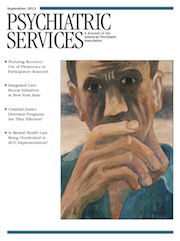Creating a “Pull Request” for Collaborative Care
Until recently, mental health services have been provided by licensed mental health professionals, and psychiatric medications have been prescribed mostly by psychiatrists. However, a significant portion of mental health services is now provided outside traditional mental health venues. Estimates from a study by Mark and colleagues published in this journal in 2009 indicated that 79% of antidepressants, 87% of anxiolytics, and 51% of antipsychotics are prescribed by nonpsychiatrists. In addition, 50% of all U.S. patients being treated for depression receive treatment in the primary care sector.
Despite the promise that such a shift would improve access to mental health treatment, research has shown that inequalities in access have increased and that the treatment offered in the primary care sector is not in accordance with accepted standards of care. To make matters worse, for patients seen in primary care clinics, obtaining a referral to a psychiatrist is often twice as difficult as obtaining referrals to other medical specialists.
Antidepressants are currently the most prescribed class of medication in the United States, reflecting their expanded use in populations for which their efficacy is established as well as their extended use among new patients for whom the marginal benefits are less clear. Overtreatment is only half the problem, because in many cases undertreatment is a significant issue. Estimates based on data from the National Comorbidity Survey indicate that only 30% of persons with a DSM-IV diagnosis currently receive treatment and half of those who receive treatment don’t have a DSM-IV diagnosis. This problem is reflected in the paradoxical way society reacts to the field of psychiatry. Complaints that psychiatrists overprescribe medication and pathologize normal emotions appear alongside complaints about undertreatment and restricted access to mental health services. How can a profession be accused of doing too much and too little at the same time?
Is there a perfect storm forming on the horizon? More people are being treated for mental illness in the primary care sector, most psychotropic prescriptions are written by nonpsychiatrists, off-label prescribing is increasing in cases for which there is little evidence of effectiveness, and referrals to specialists are becoming ever more difficult. Don’t psychiatrists bear responsibility for mental health services that are delivered by nonpsychiatrists? I believe that the need to integrate psychiatry into the primacy care sector is not an option but a necessity, not only because it will improve access, reduce disparities, and increase effectiveness but also because as professionals we have the moral responsibility to continuously improve the quality of mental health services, regardless of where they are provided. With knowledge comes power, and with power comes great responsibilities.



